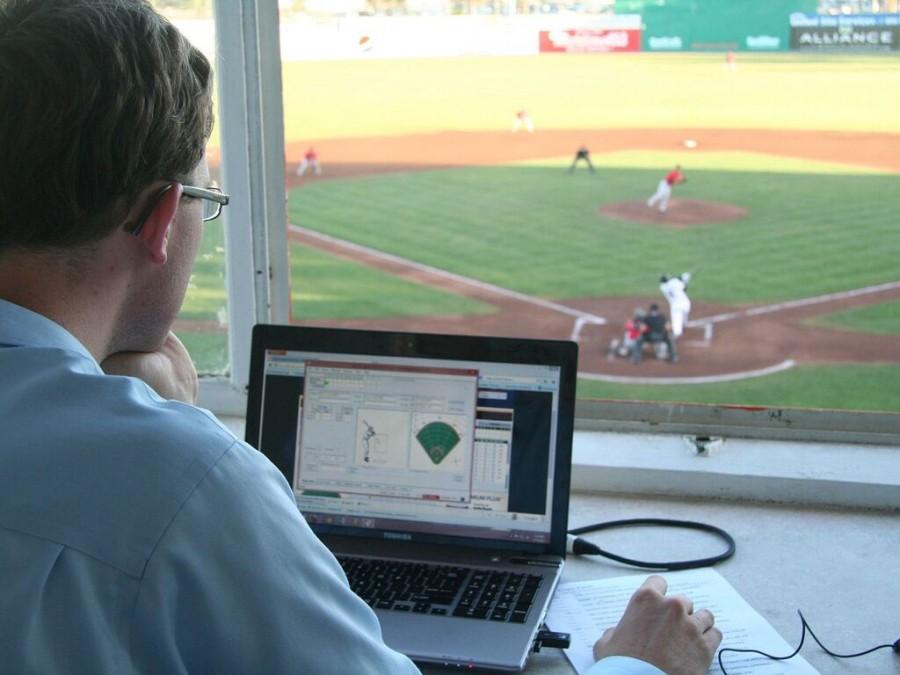More Than Economics: A Lesson From Dr. Wenz
Intel Free Press via Wikimedia Commons
Sabermetrics changed how teams are put together and puts stock in players who don’t have flashy stats.
November 3, 2015
The Independent caught up with NEIU economics professor, Dr. Michael Wenz, who has professional insight of sabermetrics. According to the online dictionary, saber metrics are the statistical and mathematical analysis of baseball records. He may claim he’s no “rainman,” but after my discussion with Dr. Wenz I learned he’s much more than an economics professor.
Going into the interview, I’d say I had a basic understanding of what sabermetrics was or how it’s used. Although it’s used in the baseball leagues, I wanted to know if these metrics could be incorporated in football and help Chicago’s struggling football team.
Independent: “What are sabermetrics and is it possible to implement a similar data tracking system in other sports?”
Wenz: “Sabermetrics is the term for the ‘Society of the Advancement of Baseball Research.’ The goals of ‘saber’ are to develop ways to analyze and quantify performances as they happen and try to predict what people are going to do in the future. It gives credit where credit is due which is something that can be done in all sports.”
Independent: “So it’s possible for these advanced metrics to make a splash in football?”
Wenz: “Certainly in football. I think the good teams are already using them. Over the last few years, teams have learned which positions are more valuable. A good left tackle is worth a whole lot more than a position like running back. It’s a lot harder to replace a good tackle than a running back because there’s a better chance that other running backs will find similar success.”
Independent: “How accurate are these stats and how do they show a player’s progression?”
Wenz: “The ability to collect data with software and player-tracking has come a really long way. Soon you won’t have to rely on a player’s forty-yard dash time or cone drill performance to determine how well they move; you’ll be able to measure that on the field. I remember when I collected data for the Kansas City Chiefs during the time I worked for Stats LLC, a company that tracked the analytics of baseball, football, basketball, and hockey. For each play, you’d come up with twenty questions to try and answer why the play happened the way it did. One of the popular athletes that played for the Chiefs was Dale Carter, a Pro Bowl defensive back. The first year he was fantastic, the second he was good, and then after that it seemed he got progressively worse. After the third season, he was traded to the Arizona Cardinals where he turned out to be a bust. Although the statistics remained consistent, he was a Pro Bowl player that was falling apart.”
Independent: “When did people start using metrics in baseball?”
Wenz: “The first meaningful paper that started sports in economics came out in the early ‘70s by James Quirk and Mohamed El-Hodiri. It was called the ‘Economic Model of a Professional Sports League’ and was the first of its kind. Bill James came along later that decade and really popularized analytics. Even before them though, baseball tracking really dates back to when they started putting stats on the back of baseball cards.”
Independent: “Now that we’re on the topic of baseball, how are you feeling about the Cubs after their loss?”
Wenz: “The one thing that I’ll say is that they’re in a position to spend money like it’s nobody’s business. What they want to find is twenty-five guys that can make an impact. The Cubs have so many people on favorable contracts. It’s time to narrow the window and find people who have a high probability of paying off.”
Independent: “When Theo Epstein was hired in 2011 it was well known that he was a numbers guy from the time he spent in the Boston Red Sox organization. Did you buy into him right away because you’re a numbers man yourself?”
Wenz: “Absolutely. The things Theo picked up on were things that were undervalued. He was ahead of the curve for the need of drafting advanced hitters. The steroid era sucked hitting out of baseball like a vacuum. I think Theo recognized that there would be this vacuum and there would be a need to find people that could hit right off the bat. He’s also really good at finding someone who is a good candidate for a bounce-back and trading them for prospects to restock their farm system. A great example of this was the trade with the Baltimore Orioles in which we received Jake Arrieta and Pedro Strop for Scott Feldman.”
Independent: “Now that Chicago fans have seen their Cubs become an MLB powerhouse with the help of sabermetrics, is this as good as it gets or is this just the tip of the iceberg?
Wenz: “This is a big offseason. I think that the Cubs are about a year ahead of where Theo and Jed thought they were. The recipe to win is to stockpile an organization with bats and buy pitching when it’s healthy. Right now they are set up to start buying.”
Independent: “Anyone in particular that you’re excited about next season?”
Wenz: “I think Jorge Soler bounces back and is better next year. He could take the lead next year as Cubs players go. Watch what happens to Jason Hammel next season, he has potential to turn into a Clayton Richard or Travis Wood. I bet he becomes a pretty good long reliever.”
Although it seems that the NFL and other sports are years behind the MLB, as far as tracking stats go, there’s still a lot of data out there that people don’t know what to do with yet. Each sport is uniquely different, so how information is applied will be better understood in the years to come. Dr. Wenz’s insight painted an image of brighter things to come for the Cubs’ organization, a sigh of relief a lot of people needed following the National League Championship Series elimination. While other sports teams try to understand how to implement data and create a winning culture, the Cubs already have a blueprint that showed they were a year ahead of what the numbers predicted. Even though 2015 wasn’t Chicago’s “magical year,” next year certainly looks very promising for the city that never says never.






